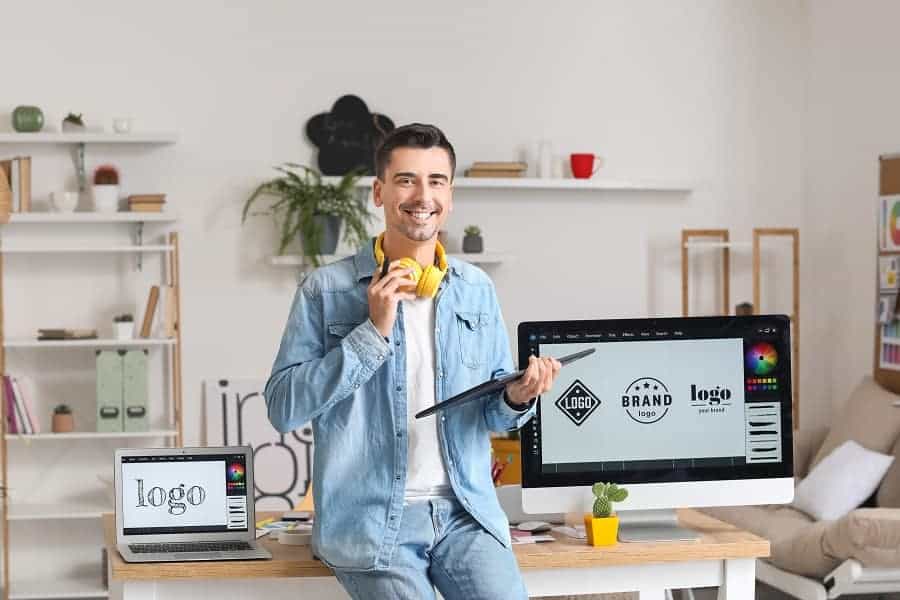The lawn and garden equipment market is experiencing a real boom. The COVID-19 pandemic has changed priorities for millions of people. Families have ...
The Visual Toolkit for Entrepreneurs: Design Advice for Novice Non-Designers
Written by: Howard Tillerman
Howard Tillerman is the Chief Marketing Officer for Step By Step Business and an award-winning marketing professional.
Published on July 16, 2025

Imagine that you have just had a brilliant idea for a business. Your enthusiasm, drive, and invigoration are palpable. You buy the domain name, set up your LLC, and potentially secure your first customer. However, most aspiring business owners find it extremely difficult to develop a brand identity that genuinely appears professional.
Create? Isn’t that the purpose of marketing firms and graphic designers?
Not anymore, that is.
With today’s easily accessible tools and user-friendly platforms, you-yes, even without a design degree-can create a visually appealing, consistent, and on-brand identity. It only requires the appropriate set of tools, a little imagination, and some careful direction. Your road map is this article.
The Significance of Visual Identity (Even at Day One)
First impressions are visual, so let’s be clear about that. A potential customer’s brain does not immediately process your brand story or pricing strategy when they visit your website, view your packaging, or receive your business card. Colors, shapes, alignment, and overall “vibe” are all processed by it. That “vibe”? It’s known as visual identity, and it frequently makes or breaks trust.
Furthermore, this does not imply that your fonts must be on par with Vogue’s or that your logo must resemble Apple’s. It means that your branding must be recognizable as yours, coherent, and intentional.
First Step: Construct from the Ground Up
Consider this before you even launch Canva or start experimenting with templates:
How do I want others to perceive my brand?
Who am I attempting to contact? Am I edgy and modern? Kind and amiable? Should my design be extravagant or exclusive?
Your design decisions should reflect both your personality and the expectations of your audience. While a tech consultant might prefer clean lines and neutral colors, a bakery startup might favor warm tones and hand-drawn fonts. First, clarity. Second, tools.
Creating Your Logo Without Sleep Deprivation
Most early entrepreneurs don’t need a custom $3,000 logo. A simple, scalable, and recognizable mark that complements your brand personality is what you need. Tools such as an AI logo generator can help with that. These platforms generate dozens of customizable logo options tailored to your industry, preferred style, and business name. Imagine brainstorming with a speedy robot designer.
Some pointers for assessing logos:
- Simplicity wins. Think of more precise lines, fewer shapes. Avoid trendy icons unless they accurately represent you (everyone is doing swooshes in 2025).
- Verify that it appears well in black and white. It will function anywhere if it is monochrome.
- Additionally, keep in mind that your brand is more than just your logo. It is merely a handshake. The way you consistently present yourself represents the remainder of your brand.
Colors, Fonts, and Every Other Invisible Choice
Most people aren’t even aware of how much a font can convey. Quicksand is a playful, rounded font. Like Playfair Display, but with a sharp serif? Sophisticated. Avoid using more than two fonts for headings and body text if you’re a new business owner.
Color selection also has psychological power. Studies have shown that people feel colors before they think. Green represents growth, red represents energy, and blue represents trust. Select two or three colors that you can use everywhere, such as on your invoices and Instagram feed.
Are you feeling stuck? Start with the color scheme of your logo and work your way up from there. A complete brand book is not necessary; all you need is consistency.
Do It Yourself Images Without a Design Degree
Imagine creating your first pitch deck, flyer, or social media post. You could look at a blank screen for hours on end. You could also use templates. Templates for almost every use case are preinstalled on platforms such as Canva, Adobe Express, and even Google Slides. Once you add your logo, colors, and fonts, your brand will appear consistent throughout.
Do you want to add some style? Consider utilizing a QR code maker. It can be linked to a product video, your website, or a promotional page. It’s a minor detail that gives your company a polished appearance.
An example from real life: I once came across a dog groomer who used QR codes on flyers to direct people to an Instagram reel of her in action. The following week, bookings doubled. Visual narrative is superior.
Maintain Tight Branding Across Touchpoints
Many non-designers make the mistake of treating each touchpoint – including emails, packaging, websites, and Instagram – as distinct design projects. The outcome? A brand that seems disorganized.
Use your visual toolkit as a style guide instead. Identical hues. The same tone. Same feeling. Consistency makes you appear professional, even if you’re working from your kitchen table and using various tools or platforms. For example, if you create your first invoice using a template, use that same structure when making presentations or brochures. Even if your audience isn’t aware of the reasons behind their attraction to your brand, this cohesiveness fosters trust and recognition.
Let Technology Fill the Gaps: You Don’t Need to Handle Everything
You may lack coding skills. You might not be a designer. You don’t have to be either, though, because of the popularity of the no-code platform. No technical expertise is required to create fully functional, aesthetically pleasing websites and apps that represent your brand effectively using platforms like Webflow, Bubble, or Glide.
When you combine that with visual aids like Figma, LottieFiles, or AI design assistants, you’ll find that your company has a visual presence on par with well-funded startups.
Indeed, you can enter your logo, choose your colors, and maintain a polished appearance with even the most basic no-code tools.
You Can Do This
Building a brand that feels genuine and looks good doesn’t require you to be a skilled designer. With the right resources and a bit of perseverance, you can create images that capture the essence of your company and earn the trust of your target audience. Be consistent, start small, and prioritize clarity over perfection. You now have the visual toolkit to support the meaningful thing you’re creating.
Subscribe to Our Newsletter
and gain insider access to cutting-edge business insights and trends.
Featured Resources

Spare Parts vs. Big Equipment: Which Business Model Brings Higher Profit in the Home and Garden Market?
Published on December 9, 2025
Read Now

How to Prepare for Your First Business Trip
Published on December 2, 2025
Your first business trip feels exciting. It feels nerve-racking at the same time. You want to look prepared. You want to make a strong impression.Yo ...
Read Now

Unit4 Review 2025: The First ERP Built for Nonprofits, Not LLCs
Published on December 2, 2025
Every year, millions of Americans take the leap into entrepreneurship. In fact, no less than 5.5 million new business applications were filed in the ...
Read Now
Comments